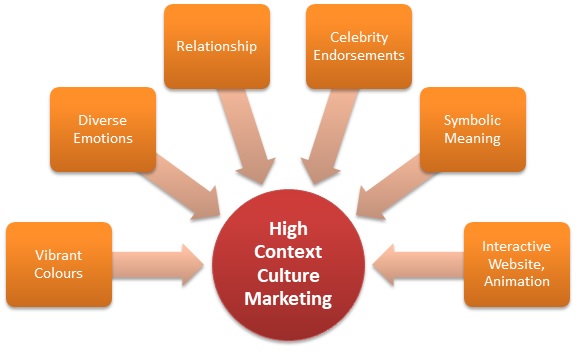- Business Concepts ›
- Marketing and Strategy ›
- High Context Culture
High Context Culture
Definition, Importance & Example
This article covers meaning & overview of High Context Culture from marketing perspective.
What is meant by High Context Culture?
A high context culture is one where most of the communication is done indirectly and more dependence is on non-verbal communication and gestures. In a high context culture, relationships are built slowly which are generally long term and stable and are dependent on trust and loyalty. High context culture is mostly found in Asian, African, Latin American and central European countries.
Importance of High Context Culture
The field of Intercultural Communication was founded in 1959 by Anthropologist Edward Hall with his book 'The Silent Language'. Intercultural Communication refers to the way people communicate in different cultures and how explicitly is message transferred. Hall categorized Intercultural Communication into High Context and Low Context communication to describe how cultural differences affect communication. The sense of collectivism is high and authority is mainly centralized.
More emphasis is on nonverbal elements like facial expressions and gestures. There are clear boundaries of who is accepted and who are outsiders. People are sensitive to conflicts and the attempt is towards avoiding conflicts or resolving as soon as possible. More importance is given to group-think and accuracy. People are usually slow to change.

Difference Between High Context and Low Context Cultures
Marketing communication is usually different for high context and low context cultures. In a high context culture, a product is advertised through vibrant visuals with a blend of colors, diverse emotions which portray relationships and symbolic meanings. Endorsements by celebrities are generally more successful too. Package design is also done accordingly with a preference for loud colors. Even business' websites are localized as per high context or low context culture. The websites in Asian countries have heavy use of graphics with minimal texts and are bright and colorful. Websites have animations, graphics, sounds, and varied interactive elements.
While in high context cultures, communication is done primarily through nonverbal mediums and gestures, in low context cultures, information is vested explicitly so that there is no risk of confusion. Mostly, western cultures are low context cultures like the UK, Australia, and the United States. While in high context cultures, authority is centralized, low context cultures believe in decentralized social structure. There is the least emphasis on nonverbal elements and as opposed to collectivism, the sense of privacy is strong in low context cultures. Unlikely high context cultures, where relationships are built slowly with clear boundaries, relationships are rather short lives in low context cultures with ambiguous boundaries which allow several people to be included in a certain social circle.
Advantages of High Context Culture
1. As the social structure is centralized, the top leader is primarily responsible for maintaining harmony in the group and the advantage is that deals can be made with the person who has authority over the group.
2. Since high context cultures believe in the sense of collectivism, there is a sense of belonging and security. Group cohesiveness is high and individuals are motivated to attain goals working in groups.
3. Accuracy, problem-solving and group learning is encouraged which enhances efficiency.
4. Relationships are personal, long term and based on trust and loyalty which brings about a humane approach while solving conflicts.
Disadvantages of High Context Culture
1. In high context culture, there is a risk of misunderstanding as communication is mostly nonverbal.
2. Since disagreements are generally personalized and focus is on conflict resolution before progressing the task, there is a risk of neglecting the tasks or not completing them in time in an attempt to resolve conflicts.
3. People respond very slowly to changes which make it difficult to adapt to fast-changing circumstances.
Examples of High Context Culture
1. The relationship of mother and child in Indian Advertisements like Vicks, Complan, Colgate, Clinic Plus, Dettol and Surf Excel.
2. Storytelling with targeting the emotions of the audience have been used in various ads like Fortune Oil where an old lady requests every day the nurse to feed his grandson who is in hospital. The emotions of the old lady, the nurse, and the grandson when he finally gets to eat the home-made food from his grandmother appealed millions of viewers.
3. Similarly, Birla Sun Life Sun Insurance made a commercial which plays like a short film of 3 minutes showcasing the emotional journey of an autistic kid with his father who has lost his wife and job.
4. IKEA's website in Japan is very different from its American website. In the Japanese website, there is heavy use of graphics and animation and is very bright and colorful with scrolling graphics.
5. In India, about 65% of customers try on new products due to their packaging.
Hence, this concludes the definition of High Context Culture along with its overview.
This article has been researched & authored by the Business Concepts Team which comprises of MBA students, management professionals, and industry experts. It has been reviewed & published by the MBA Skool Team. The content on MBA Skool has been created for educational & academic purpose only.
Browse the definition and meaning of more similar terms. The Management Dictionary covers over 1800 business concepts from 5 categories.
Continue Reading:
What is MBA Skool?About Us
MBA Skool is a Knowledge Resource for Management Students, Aspirants & Professionals.
Business Courses
Quizzes & Skills
Quizzes test your expertise in business and Skill tests evaluate your management traits
Related Content
All Business Sections
Write for Us